As someone who has traveled to Vietnam and experienced its cuisine, I was surprised to find that Vietnamese peanut sauce is not as ubiquitous there as it is in other parts of the world.
However, this flavorful condiment has gained a devoted following worldwide, and for good reason. We will explore everything there is to know about Vietnamese peanut sauce, from its history and ingredients to its cultural significance and health benefits.
See also: How to Make Vietnamese Sate Sauce?
What is Vietnamese peanut sauce?
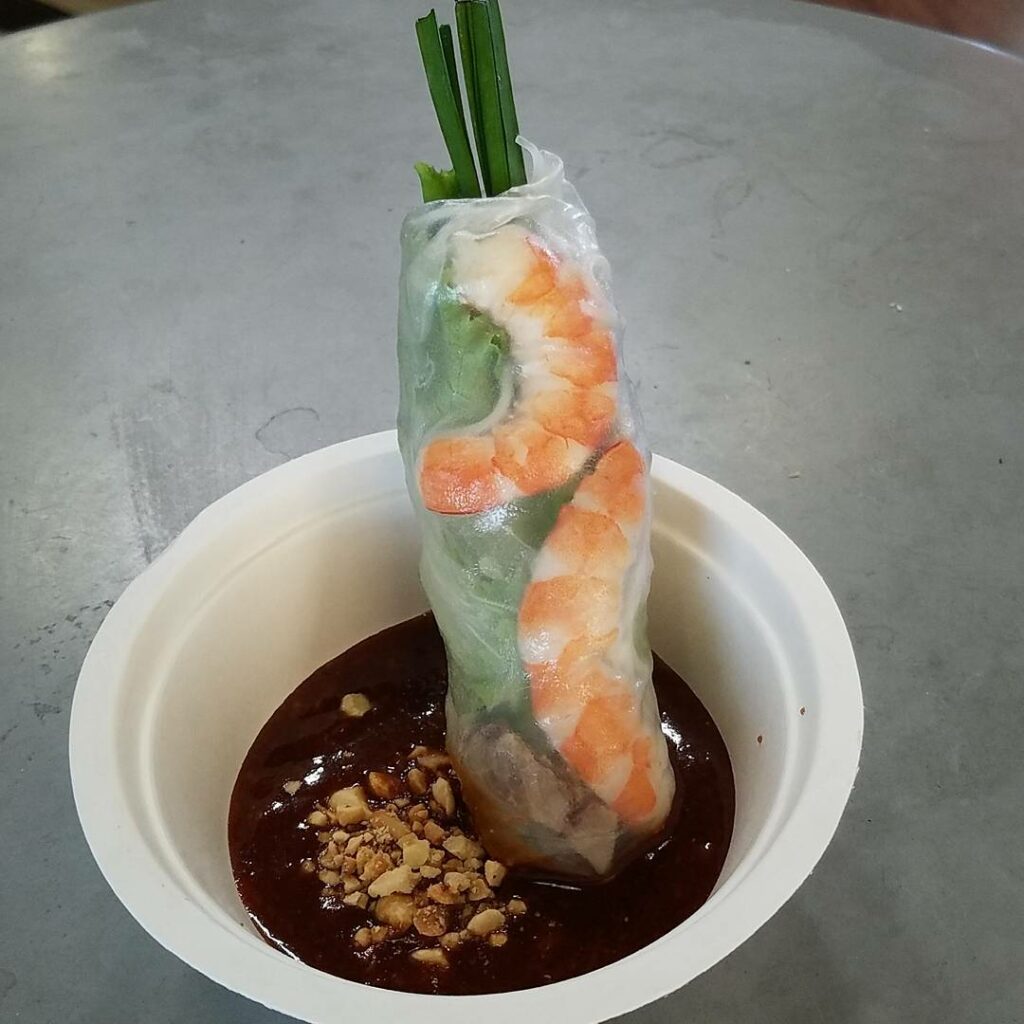
Vietnamese peanut sauce (also called “Vietnamese spring roll sauce”) is a popular condiment made from ground roasted peanuts, oil, and spices, and often includes additional ingredients like garlic, ginger, and hoisin sauce. It has a rich and savory flavor that’s slightly sweet, tangy, and salty, with a nutty aroma.
The origins of Vietnamese peanut sauce are not entirely clear, but it is believed to have originated in Southern Vietnam and became popular in the United States during the 1970s with the rise of Vietnamese cuisine.
In Vietnamese cuisine, peanut sauce is a common condiment for grilled meats, spring rolls, and noodle dishes. It is also used as a dipping sauce for vegetables and a marinade for meats.
Peanut sauce holds cultural significance in Vietnamese cuisine as a condiment that adds depth and complexity to dishes. The sauce is often associated with the southern region of Vietnam, where peanuts are grown and used frequently in cooking. Peanut sauce is also enjoyed in other Asian cultures and has been adapted to suit different tastes and preferences.
Vietnamese peanut sauce recipe
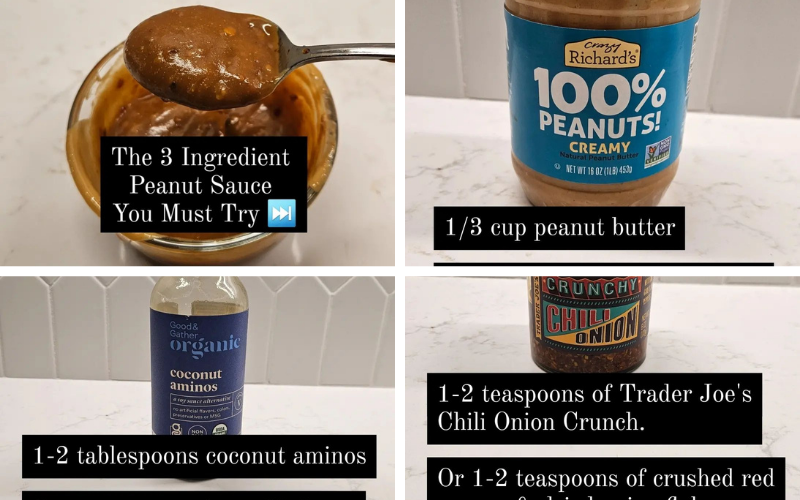
To make 1 cup of Vietnamese peanut sauce, follow the Vietnamese peanut sauce recipe and ingredients below:
Cooking note
- Serving: 1 cup
- Prep Time: 10 minutes
- Cook Time: 5 minutes
- Total Time: 15 minutes
- Course: Condiment
- Cuisine: Vietnamese
- Equipment: blender, saucepan
Ingredients
The recipe for Vietnamese peanut sauce is already too clear, so to answer the question of what’s in Vietnamese sauce, here are some ingredients that need to be in peanut sauce in Vietnamese it will help you in the process of making the sauce:
- 1 cup roasted peanuts (unsalted)
- 1/4 cup water
- 2 cloves garlic, minced
- 1 tablespoon soy sauce
- 1 tablespoon hoisin sauce
- 1 tablespoon honey
- 2 tablespoons vegetable oil
- 1 tablespoon lime juice
- 1/4 teaspoon red pepper flakes (optional)
Note: The quality of ingredients can impact the final product of the peanut sauce. It’s recommended to use high-quality roasted peanuts, fresh garlic, and lime juice for the best flavor. Additionally, adjusting the amount of water can help achieve the desired consistency.
How to make Vietnamese peanut sauce?
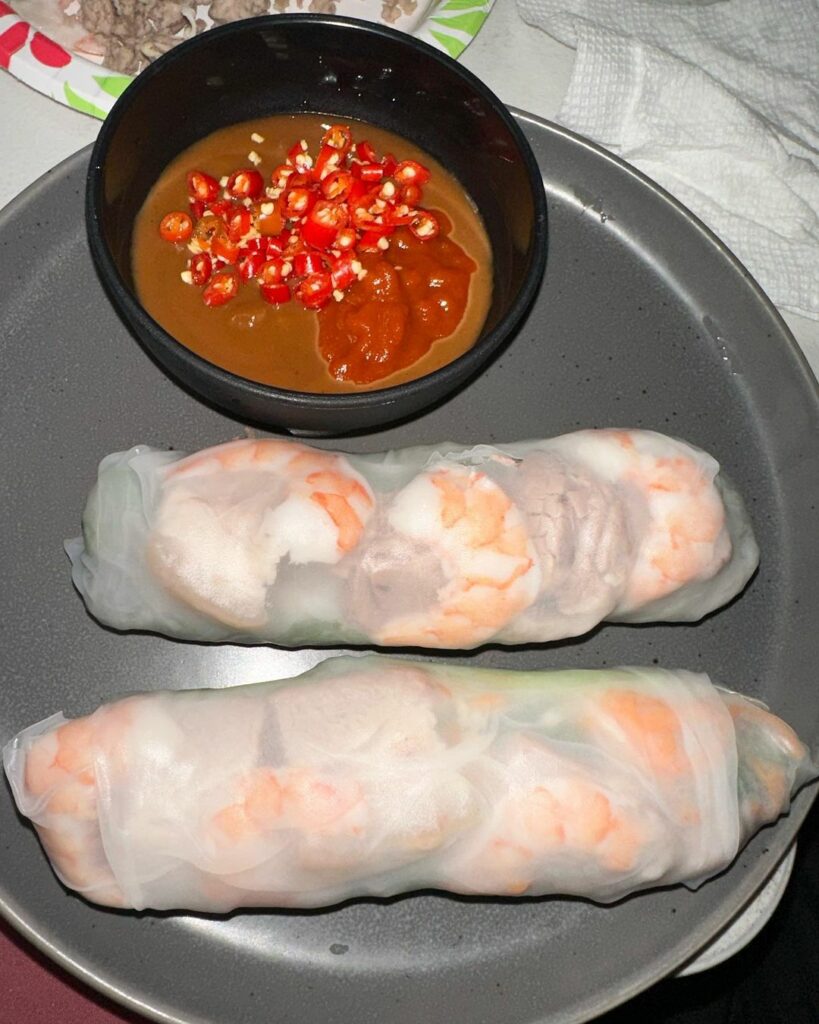
Step-by-step instructions for making Vietnamese peanut sauce:
- Grind the roasted peanuts in a food processor or blender until they become coarse powder.
- In a saucepan, combine the ground peanuts, water, minced garlic, soy sauce, hoisin sauce, honey, vegetable oil, lime juice, and red pepper flakes (if using).
- Cook the mixture over medium heat, stirring frequently, until it becomes smooth and creamy, about 5 minutes.
- Remove the saucepan from the heat and let the peanut sauce cool to room temperature.
- Taste and adjust the seasoning to your liking, adding more soy sauce, honey, or lime juice as needed.
- Serve the Vietnamese peanut sauce as a dipping sauce or condiment with your favorite Vietnamese dishes.
How to customize the sauce to suit different tastes?
Vietnamese peanut sauce is a versatile condiment that can be customized to suit different tastes. Here are some ways to adjust the recipe:
- Spiciness: If you prefer a spicier peanut sauce, add more red pepper flakes or sriracha sauce to the recipe. Conversely, if you don’t like spicy food, omit the red pepper flakes altogether.
- Sweetness: Adjust the sweetness of the peanut sauce by adding more or less honey to the recipe. If you prefer a sweeter sauce, you can also add a pinch of sugar or use sweetened condensed milk instead of honey.
- Tanginess: For a tangier peanut sauce, add more lime juice to the recipe. Alternatively, you can use rice vinegar or tamarind paste to achieve a sour flavor.
- Nutty flavor: If you want a more pronounced nutty flavor, use chunky peanut butter instead of roasted peanuts. You can also add roasted sesame seeds or cashews to the recipe for added texture and flavor.
- Creaminess: To make the peanut sauce creamier, add a tablespoon of coconut milk or heavy cream to the recipe.
By experimenting with different ingredients and adjusting the quantities, you can create a custom Vietnamese peanut sauce that perfectly suits your taste preferences.
Table about nutrient facts of Vietnamese peanut sauce
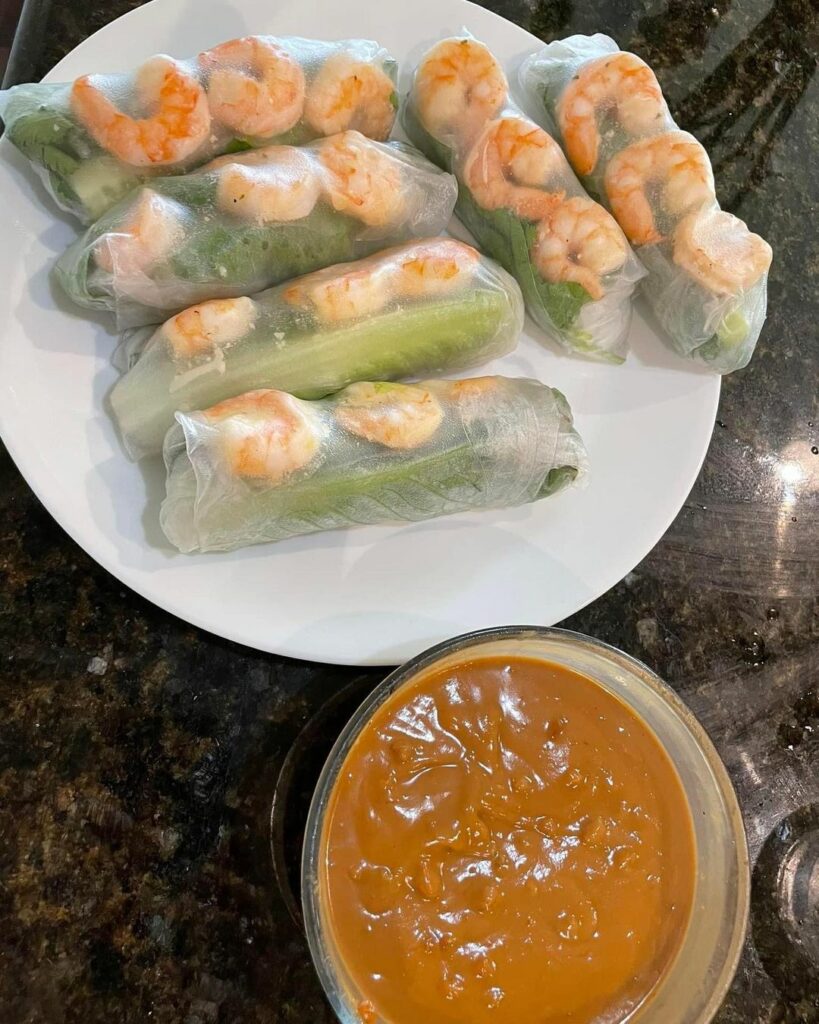
Here is a table about the nutrient facts of Vietnamese peanut sauce:
| Nutrient | Amount |
| Calories | 70 |
| Total Fat | 6g |
| Saturated Fat | 1g |
| Cholesterol | 0mg |
| Sodium | 78mg |
| Total Carbohydrates | 3g |
| Dietary Fiber | 1g |
| Sugars | 1g |
| Protein | 2g |
Note: These nutrient values may vary depending on the specific recipe and ingredients used. So, “how many calories in Vietnamese peanut sauce” it will fall into 70 calories for 1 cup of Vietnamese peanut sauce. Peanut sauce in Vietnamese is a relatively high-calorie condiment due to its fat content.
However, peanuts and peanut products have been found to have various health benefits, including reducing the risk of heart disease and promoting weight loss. Peanuts are a good source of protein, healthy fats, and fiber, which can help you feel full and satisfied after consuming them.
Additionally, the monounsaturated and polyunsaturated fats found in peanuts have been linked to lower cholesterol levels and improved heart health. Consuming Vietnamese peanut sauce in moderation, as part of a balanced diet, can provide a tasty and healthy addition to your meals.
Variations of Vietnamese peanut sauce
Some variations of Vietnamese peanut sauce:
- Coconut milk peanut sauce: To create a creamier peanut sauce, you can add coconut milk to the recipe. Vietnamese peanut sauce with coconut milk variation of Vietnamese peanut sauce is particularly popular in Thai cuisine.
- Vegan Vietnamese peanut sauce: To make the peanut sauce vegan-friendly, you can use tamari sauce instead of soy sauce and maple syrup or agave nectar instead of honey.
- Sweet Vietnamese peanut sauce: To create a sweeter version of the sauce, add more honey or use sweetened condensed milk instead of honey.
- Garlic peanut sauce: Add extra garlic to the recipe to create a more pronounced garlic flavor in the peanut sauce.
- Lemongrass Vietnamese peanut sauce: Adding lemongrass to the recipe can add citrus and floral flavor to the sauce. Finely mince fresh lemongrass and add it to the saucepan while cooking.
- Ginger Vietnamese peanut sauce: Adding ginger to the recipe can give the sauce a zesty and refreshing flavor. Finely mince fresh ginger and add it to the saucepan while cooking.
What to serve with Vietnamese peanut sauce?
Vietnamese peanut sauce is a flavorful and versatile dipping sauce that well with a variety of dishes. Here are some popular options to serve with Vietnamese peanut sauce:
- Spring rolls: Of course, the name “Vietnamese spring roll sauce” also comes from here. It is a classic accompaniment to fresh spring rolls, also known as summer rolls. These rolls are filled with fresh veggies, herbs, and protein and are typically served with a peanut dipping sauce.
- Grilled meats: Vietnamese peanut sauce is a tasty marinade for grilled meats such as chicken, pork, or beef. You can brush the sauce on the meat before grilling, or use it as a dipping sauce for the cooked meat.
- Noodle dishes: Vietnamese peanut sauce can be a delicious dressing for noodle dishes, such as cold noodle salads or noodle bowls. Toss the noodles with the sauce and your choice of veggies, protein, and herbs for a tasty meal.
- Stir-fries: Vietnamese peanut sauce can also be used as a finishing sauce for stir-fries. Simply stir in the sauce at the end of cooking for a rich and flavorful dish.
- Sandwiches: Vietnamese peanut sauce can be a tasty spread for sandwiches such as banh mi. Spread the sauce on the bread and layer with your choice of meats, veggies, and herbs.
Vietnamese peanut sauce can be used in a variety of ways to add a delicious and unique flavor to your dishes.
Read more: How to Make Soft and Airy Vietnamese Baguette? A Step-by-Step Guide
What are alternatives ingredients to peanut sauce?
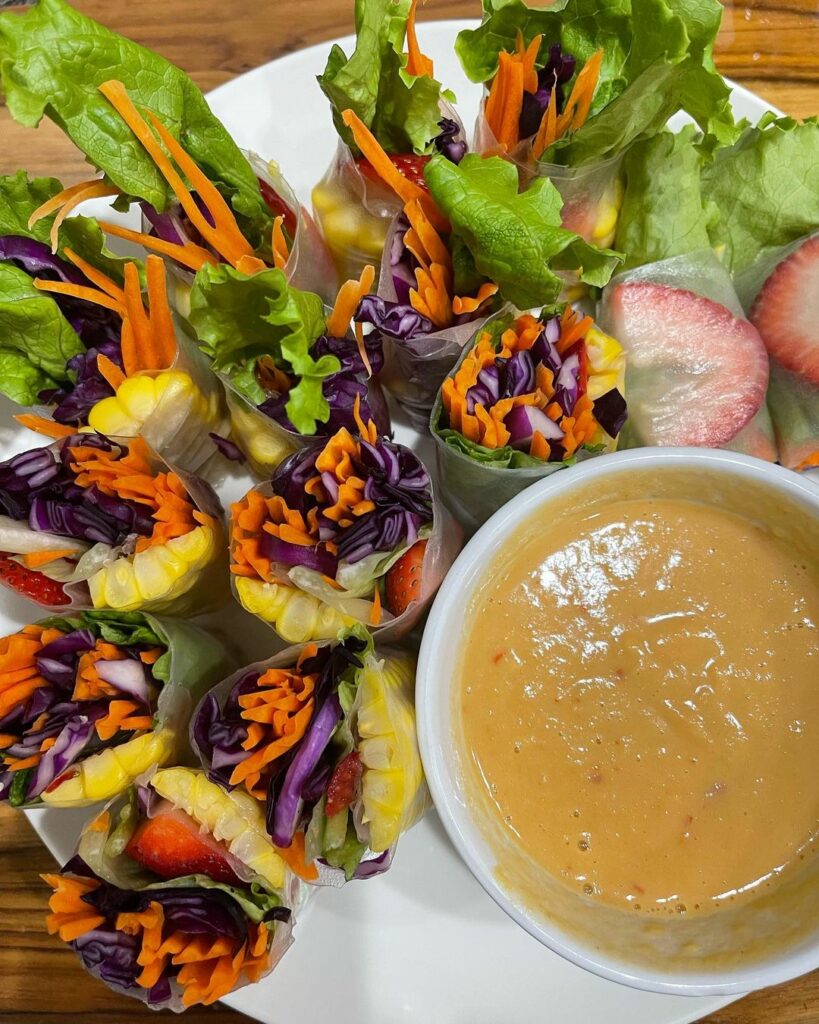
While peanut sauce is a popular and delicious condiment, it may not be suitable for everyone due to allergies or personal preferences. Here are some alternative ingredients to peanut sauce that you can use:
- Almond butter: Almond butter has a similar texture and flavor to peanut butter, making it a great alternative in sauces and dressings.
- Cashew butter: Cashew butter has a creamy and mild flavor, making it a good substitute for peanut butter in sauces and dressings.
- Sunflower seed butter: Sunflower seed butter has a nutty flavor and can be used in place of peanut butter in sauces and dressings.
- Tahini: Tahini is made from ground sesame seeds and has a nutty flavor similar to peanut sauce. It is commonly used in Middle Eastern and Mediterranean cuisines.
- Soy sauce: Soy sauce has a salty and savory flavor and can be used as a dipping sauce or marinade for meats and vegetables.
- Hoisin sauce: Hoisin sauce is a sweet and savory sauce made from fermented soybeans, garlic, and chili peppers. It can be used as a dipping sauce or marinade for meats.
How to store Vietnamese peanut sauce?
To prolong the shelf life of Vietnamese peanut sauce, it’s important to store it properly. Here are some storage techniques for Vietnamese peanut sauce:
- Refrigerate: Store leftover peanut sauce in an airtight container in the refrigerator. The cold temperature will slow down the growth of bacteria and help the sauce stay fresh for longer.
- Use clean utensils: When serving or scooping out the peanut sauce, always use clean utensils to prevent contamination.
- Avoid cross-contamination: Make sure that the peanut sauce does not come into contact with any raw meat or other ingredients that could contaminate it.
- Check for spoilage: Before using the peanut sauce, check for signs of spoilage such as a strange odor, mold, or discoloration. If you notice any of these signs, discard the sauce immediately.
- Freeze: If you have a large batch of peanut sauce that you won’t be able to use within a week or two, consider freezing it in an airtight container. Peanut sauce can be frozen for up to 2-4 weeks
With these storage techniques, you can prolong the shelf life of Vietnamese peanut sauce and enjoy it for longer. Remember to always practice proper food safety and hygiene when handling and storing any type of food.
What are popular brands of Vietnamese peanut sauce?
There are many brands of Vietnamese peanut sauce available in stores and online. Here are some popular brands of Vietnamese peanut sauce name:
- Lee Kum Kee: Lee Kum Kee is a well-known brand that offers a range of Asian condiments and sauces, including Vietnamese peanut sauce.
- Thai Kitchen: While primarily known for its Thai products, Thai Kitchen also offers a Vietnamese peanut sauce that can be used in a variety of dishes.
When selecting a high-quality Vietnamese peanut sauce, here are some tips to keep in mind:
- Check the ingredients: Look for a peanut sauce that is made with high-quality ingredients, such as roasted peanuts, fresh garlic, and lime juice.
- Avoid additives: Choose a peanut sauce that is free from artificial flavors, colors, and preservatives.
- Consider the texture: Look for a peanut sauce that has a smooth and creamy texture, with no clumps or lumps.
- Check the label: Look for a peanut sauce that is low in sodium and sugar, and free from trans fats.
In a high-quality Vietnamese peanut sauce, you can enhance the flavor of your dishes and enjoy the many health benefits of peanuts.
FAQs
Is Vietnamese peanut sauce vegan?
It depends on the recipe and the specific ingredients used. Some Vietnamese peanut sauce recipes contain honey, which is not vegan.
However, you can easily make a vegan version of Vietnamese peanut sauce by using maple syrup or agave nectar instead of honey. Additionally, you can use tamari sauce instead of soy sauce to make the sauce vegan-friendly.
When in doubt, check the ingredients list and look for vegan alternatives to any non-vegan ingredients. With a few simple modifications, Vietnamese peanut sauce can be a delicious and vegan-friendly condiment to enjoy.
Is Vietnamese peanut sauce spicy?
Vietnamese peanut sauce can be spicy, but it depends on the specific recipe and the number of spicy ingredients used. Some recipes call for red pepper flakes or chili paste to add heat to the sauce, while others are milder and do not contain any spicy ingredients.
If you prefer a spicy peanut sauce, you can add more red pepper flakes or hot sauce to the recipe. Conversely, if you don’t like spicy food, you can omit the spicy ingredients or use a milder chili paste. The level of spiciness in Vietnamese peanut sauce can be adjusted to suit your taste preferences.
Is Vietnamese peanut sauce gluten-free?
Yes, Vietnamese peanut sauce is typically gluten-free, as the primary ingredients are peanuts, oil, and spices. However, it’s always important to double-check the label or ingredients list, as some brands may include gluten-containing ingredients like soy sauce or wheat flour.
What are some common allergens found in Vietnamese peanut sauce?
Vietnamese peanut sauce typically contains peanuts, which are a common allergen. Other common allergens that may be found in Vietnamese peanut sauce include soy sauce, fish sauce, and peanuts. It’s important to check the ingredients list carefully if you have any food allergies or sensitivities.
If you have a peanut allergy, you should avoid Vietnamese peanut sauce altogether or try making a peanut-free version using almond or sunflower seed butter. Also, if you have any concerns or questions about allergens in Vietnamese peanut sauce, you can always check with the manufacturer or a healthcare professional.
How does Vietnamese peanut sauce enhance the flavor of dishes?
Vietnamese peanut sauce is a versatile condiment that can enhance the flavor of many different dishes in a variety of ways. Here are some ways that Vietnamese peanut sauce can enhance the flavor of dishes:
- Adds richness
- Balances flavors
- Adds texture
- Complements spices
How can you tell if Vietnamese peanut sauce has gone bad?
Vietnamese peanut sauce typically contains a variety of ingredients, including peanuts, garlic, chili, soy sauce, and vinegar. The appearance, smell, and taste of the sauce can be indicators of whether it has gone bad or not.
Here are some signs that Vietnamese peanut sauce may have gone bad:
- Appearance: If the sauce appears to have mold or has changed in color from its original hue, this may be an indication that it has gone bad.
- Smell: A bad or rancid smell may indicate that the peanut sauce has gone bad. If the sauce smells sour, funky, or off in any way, it’s best to discard it.
- Taste: If the sauce has a sour, bitter, or metallic taste, it may have gone bad. A change in taste from the original flavor may be a sign that the sauce has been contaminated or spoiled.
It’s important to note that homemade peanut sauce may have a shorter shelf life than store-bought versions. It’s best to consume the sauce within a week of making it, and to store it in an airtight container in the refrigerator. If you’re unsure about the freshness of your peanut sauce, it’s better to err on the side of caution and throw it away.
How does Vietnamese peanut sauce differ from other peanut sauces?
Vietnamese peanut sauce differs from other peanut sauces in a few ways. Here are some of the key differences:
| Vietnamese peanut sauce | Other peanut sauces | |
| Ingredients | Typically contains garlic, lime juice, and fish sauce, which gives it a unique flavor profile that sets it apart from other peanut sauces | Contain different ingredients, such as coconut milk or curry paste. |
| Consistency | Typically, thinner and runnier | The sauce is thicker |
| Flavor | Vietnamese peanut sauce has a unique combination of sweet, salty, and sour flavors that sets | Often spicier than other peanut sauces, with the addition of red pepper flakes or chili paste. |
The Vietnamese peanut sauce has a unique flavor and texture that sets it apart from other peanut sauces. Whether you’re using it as a dip, marinade, or dressing, Vietnamese peanut sauce is a delicious and versatile condiment that can add flavor and depth to a wide variety of dishes.
Conclusion
Vietnamese peanut sauce is a versatile and delicious condiment that has become popular all over the world. With its unique combination of sweet, salty, and sour flavors, Vietnamese peanut sauce can enhance the taste of a wide variety of dishes.
While traditionally used in Vietnamese cuisine, peanut sauce has also been adopted by other Asian cultures and can be found in many different variations. By following some simple tips for making and storing peanut sauce, you can enjoy this delicious condiment in your own home.
Whether you prefer a spicy or mild peanut sauce or like to customize the recipe to suit your dietary needs, there is a Vietnamese peanut sauce recipe out there for everyone. So go ahead and experiment with different ingredients and flavors to create your own perfect peanut sauce!
Vietnamese Peanut Sauce for Spring Rolls
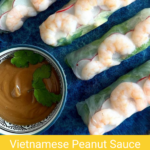
As someone who has traveled to Vietnam and experienced its cuisine, I was surprised to find that Vietnamese peanut sauce is not as ubiquitous there as it is in other parts of the world. However, this flavorful condiment has gained a devoted following worldwide, and for good reason. We will explore everything there is to know about Vietnamese peanut sauce, from its history and ingredients to its cultural significance and health benefits.
- Blender
- Saucepan
- 1 cup roasted peanuts (unsalted)
- 1/4 cup water
- 2 cloves garlic, minced
- 1 tablespoon soy sauce
- 1 tablespoon hoisin sauce
- 1 tablespoon honey
- 2 tablespoon vegetable oil
- 1 tablespoon tablespoon lime juice
- 1/4 teaspoon red pepper flakes (optional)
Grind the roasted peanuts in a food processor or blender until they become coarse powder.
In a saucepan, combine the ground peanuts, water, minced garlic, soy sauce, hoisin sauce, honey, vegetable oil, lime juice, and red pepper flakes (if using).
Cook the mixture over medium heat, stirring frequently, until it becomes smooth and creamy, about 5 minutes.
Remove the saucepan from the heat and let the peanut sauce cool to room temperature.
Taste and adjust the seasoning to your liking, adding more soy sauce, honey, or lime juice as needed.
Serve the Vietnamese peanut sauce as a dipping sauce or condiment with your favorite Vietnamese dishes.